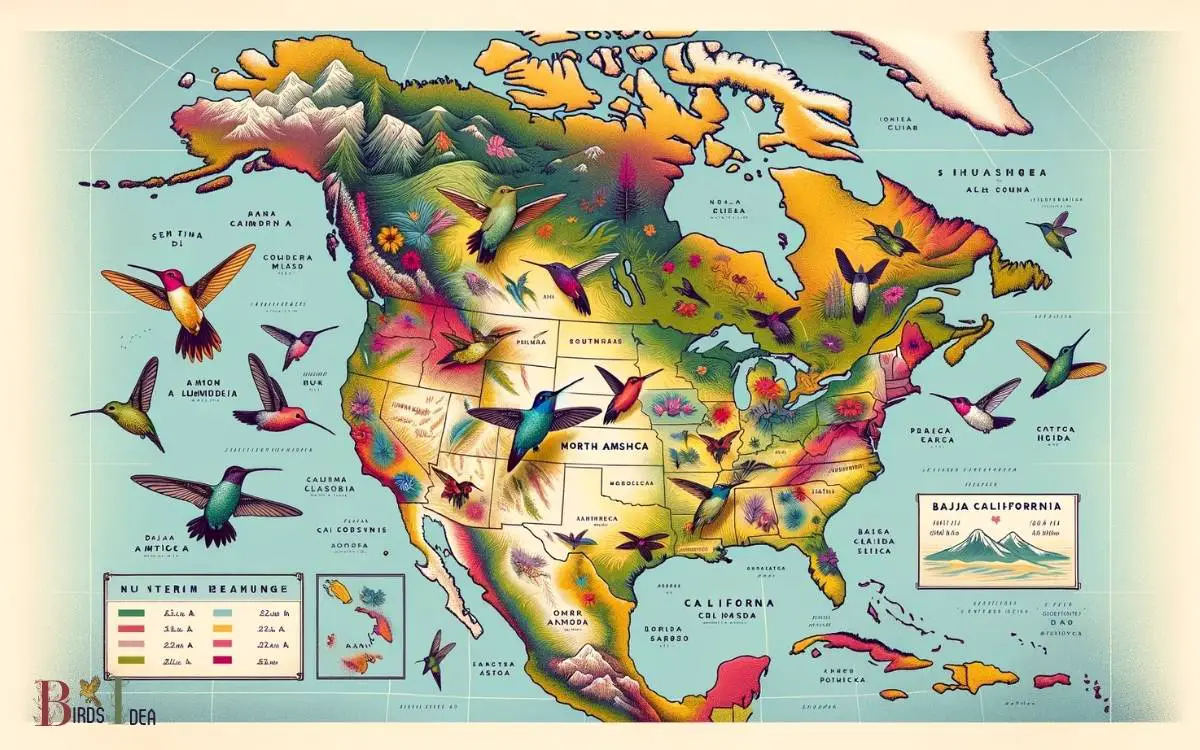Anna’s Hummingbird Map Range: Explanation!
Anna’s Hummingbird (Calypte anna) is a species native to the west coast of North America.
In recent years, the range of Anna’s Hummingbird has expanded, and they can now be found from southern Alaska to Baja California, and east to parts of Arizona and Texas. They thrive in a variety of habitats, including open woods, gardens, parks, and coastal scrub.
The map range of Anna’s Hummingbird is primarily along the Pacific coast, where its natural habitat provides the nectar and insects they need to thrive.
These birds are year-round residents within much of their range, unlike many other hummingbirds that migrate. They are known for their remarkable courtship display, involving a series of high-speed dives to impress potential mates.
Anna’s Hummingbird, recognized by its iridescent emerald feathers and rose-red head, is a frequent visitor to backyard feeders and a delight to birdwatchers across its expanding range.

Key Takeaway
Anna’s Hummingbird Overview
The Anna’s Hummingbird is a small bird species found primarily along the western coast of North America. Scientifically known as Calypte anna, it is a medium-sized hummingbird with an average length of about 3.9 inches.
This species is known for its iridescent green back and gray chest, with the males having vibrant pink-red iridescent crowns, throats, and gorgets.
Anna’s Hummingbirds are non-migratory, and their range extends from southern Canada to northern Baja California, Mexico. They inhabit a variety of habitats including coastal scrub, oak woodlands, and suburban gardens.
Their diet primarily consists of nectar from flowers, supplemented with small insects and spiders. These birds are also known for their acrobatic flight patterns, rapid wingbeats, and distinctive vocalizations.
Physical Characteristics
With its vibrant iridescent plumage and acrobatic flight patterns, the Anna’s Hummingbird possesses distinctive physical characteristics that contribute to its remarkable adaptation for survival.
The male Anna’s Hummingbird is known for its vibrant magenta-red crown and throat, which shimmers in the sunlight due to microscopic platelets in the feathers that create iridescence.
The female, while less flamboyantly colored, still exhibits a beautiful range of greens and whites. Both genders have long, needle-like bills perfectly adapted for reaching deep into flowers to access nectar, their primary energy source.
Their exceptional flight abilities, including hovering and flying in any direction, are enabled by rapid wingbeats of up to 80 times per second.
These physical attributes allow the Anna’s Hummingbird to thrive in diverse environments, from coastal regions to mountainous terrain.
Habitat Preferences
Possessing a wide range of adaptable habitats, Anna’s Hummingbirds are found in diverse environments due to their remarkable flight abilities and specialized feeding behaviors.
These hummingbirds are commonly found in a variety of habitats, including open woodlands, gardens, and urban areas along the western coast of North America.
They are known to thrive in areas with an abundance of flowering plants, which provide them with a consistent nectar source.
Anna’s Hummingbirds are also known to frequent areas with water sources, such as streams and rivers, where they can bathe and find insects for protein.
Their ability to adapt to different environments has allowed them to expand their range and thrive in both natural and human-altered landscapes, making them a common sight in many parts of their range.
Breeding Range
Anna’s Hummingbirds establish their breeding range in a variety of habitats along the western coast of North America. This range extends from southern Canada to northern Baja California, Mexico.
Within this expansive region, Anna’s Hummingbirds exhibit a preference for nesting in diverse environments, including coastal scrub, oak woodlands, chaparral, and urban areas.
The specific habitats within their breeding range provide a wealth of flowering plants, which are crucial for their nectar-based diet and the availability of suitable nesting sites.
Moreover, these hummingbirds are known to adapt to human-modified landscapes, often nesting in gardens and parks.
This adaptability contributes to their successful breeding across a range of environments, making them a resilient and widespread species.
Winter Range
During the winter months, Anna’s Hummingbirds extend their range further south, migrating to regions from southern California into Mexico.
These tiny birds are known for their ability to tolerate cooler temperatures, enabling them to survive in these more temperate climates during the winter.
The following table illustrates the winter range of Anna’s Hummingbirds:
| Region | Description |
|---|---|
| Southern California | Coastal areas and canyons with access to nectar sources |
| Baja California | Desert scrub and arid landscapes with flowering plants |
| Mexico | Various habitats including tropical forests and gardens |
During this time, these resilient birds seek out flowering plants and feeders to sustain themselves through the winter months.
Understanding their winter range is crucial for conservation efforts and ensuring the availability of suitable habitats for these remarkable creatures.
Migration Patterns
Migration patterns of Anna’s Hummingbirds extend from their summer breeding grounds to their wintering areas, demonstrating a remarkable journey of endurance and instinctual navigation.
During their migration, Anna’s Hummingbirds exhibit fascinating behaviors and adaptations:
- Route: Anna’s Hummingbirds follow a specific migration route, often utilizing landmarks and environmental cues to guide their journey.
- Navigation: These birds possess a remarkable ability to navigate over long distances, relying on a combination of celestial cues, visual landmarks, and Earth’s magnetic field.
This annual migration, driven by the search for suitable food and nesting habitats, showcases the remarkable abilities of Anna’s Hummingbirds to navigate complex landscapes and endure the challenges of long-distance travel.
Understanding their migration patterns is crucial for conservation efforts and the preservation of their vital habitats.
Range Map Analysis
The analysis of the range map of Anna’s Hummingbird involves a thorough examination of its geographic distribution.
This includes studying the various habitats and correlating them with the climate conditions to understand the species’ preferences and adaptations.
By scrutinizing these points, we can gain valuable insights into the ecological factors influencing the distribution of Anna’s Hummingbird.
Geographic Distribution Analysis
An analysis of the geographic distribution of Anna’s Hummingbird reveals its range and habitats across the western coast of North America.
This species is primarily found along the Pacific coast, from southern Canada to northern Baja California in Mexico.
The distribution analysis indicates that Anna’s Hummingbird thrives in a variety of habitats, including coastal scrub, open woodlands, gardens, and parks.
The species has also adapted to urban and suburban environments, making it a common sight in cities such as Los Angeles and San Francisco.
Additionally, within its range, the bird demonstrates flexibility in its habitat selection, often being found in diverse ecological settings such as chaparral, oak savannahs, and riparian woodlands.
- Coastal Range
- Southern Canada to northern Baja California
- Diverse Habitats
- Coastal scrub, open woodlands, urban and suburban environments
Habitat and Climate Correlation
Habitat and climate correlation for the range map of Anna’s Hummingbird is essential for understanding the species’ distribution and environmental preferences.
The table below illustrates the correlation between specific habitat types and the corresponding climate variables preferred by Anna’s Hummingbird.
| Habitat Type | Preferred Climate Variables |
|---|---|
| Coastal | Moderate temperatures, high humidity, coastal fog |
| Chaparral | Warm temperatures, low humidity, mild winters |
| Oak Woodland | Moderate temperatures, moderate humidity, mild winters |
| Urban Gardens | Varied temperatures, availability of flowers, trees, and shrubs |
Understanding the correlation between habitat and climate is crucial for effective conservation strategies and management of Anna’s Hummingbird populations.
Conservation Status
Currently, the conservation status of the Anna’s Hummingbird is classified as ‘Least Concern’ by the International Union for Conservation of Nature (IUCN).
This status is attributed to the bird’s widespread distribution across western North America and its adaptable nature.
However, despite this relatively stable status, there are still conservation efforts in place to ensure the continued well-being of the species.
These efforts include:
- Habitat Protection: Preserving and protecting the diverse habitats that the Anna’s Hummingbird occupies, such as coastal scrub, gardens, and oak woodlands.
- Habitat restoration projects: Focusing on restoring degraded habitats and creating suitable breeding and foraging areas for the hummingbirds.
- Community Engagement: Involving local communities and citizens in conservation initiatives through education, awareness programs, and citizen science projects to monitor populations and behaviors.
Conclusion
The range map of Anna’s Hummingbird provides valuable insight into the species’ distribution and migration patterns.
The analysis of the map reveals the extensive breeding range along the west coast of North America, as well as the winter range in parts of the United States and Mexico.
As we consider the conservation status of this species, it is important to recognize the significance of preserving their diverse habitats and migration routes for their continued survival.






